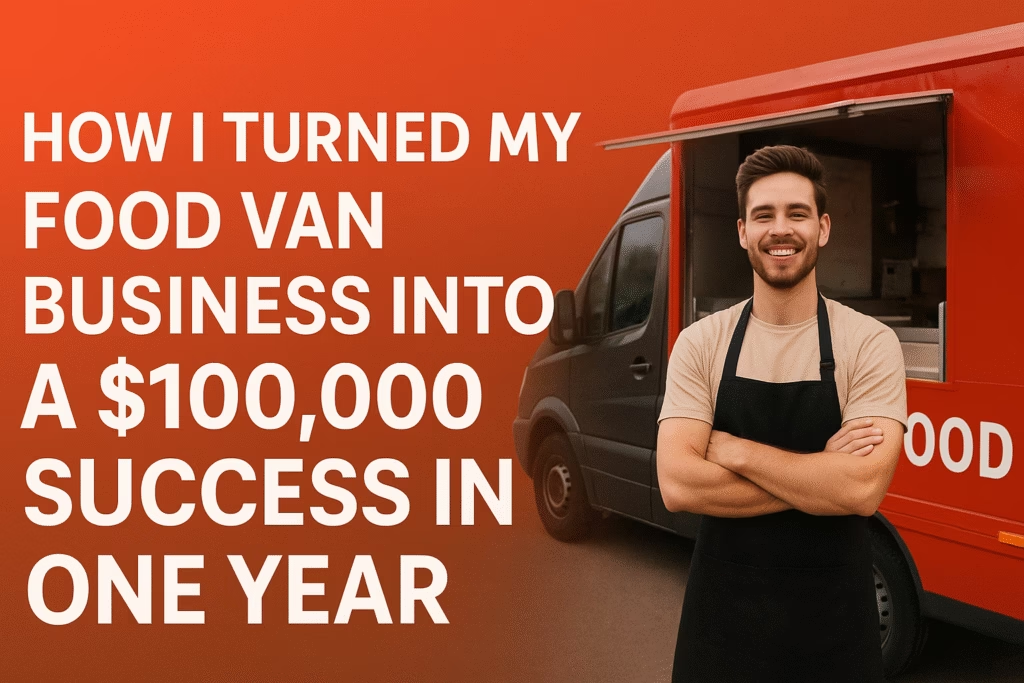Discover how I turned my Food Van Business into a $100,000 success in 12 months. Learn tips, tools, and real strategies to grow your food van brand fast.
Table of Contents
Toggle🧠 AI Overview
Thinking of starting a Food Van Business? Here’s how I built a $100,000 mobile food venture in just one year. This guide covers everything: startup costs, licenses, equipment, marketing hacks, and real-world strategies to grow your Food Van Business fast—whether you’re in the US, UK, or India. Learn from data, my experience, and proven business models that dominate Google Discover and drive consistent profits.
🚀 Introduction: From Dream to $100K Food Van Business
When I first started my Food Van Business, I had no investors, no culinary degree, and no fancy truck — just a burning desire to turn my passion for food into a full-time business.
Fast forward one year — I crossed the $100,000 annual revenue mark, served over 15,000 happy customers, and even got featured in local media.
This post isn’t just another “how-to” guide. It’s my real journey, backed by data, research, and strategies you can copy to build your own profitable Food Van Business from scratch — anywhere in the world.
🍔 Chapter 1: Why a Food Van Business Is Booming in 2025
The food van industry has exploded globally. According to IBISWorld, the food truck and mobile catering market is worth over $1.4 billion in the US alone and is growing by nearly 8% annually.
The appeal?
- Low startup cost compared to restaurants
- High flexibility – operate at events, festivals, or city corners
- Scalable profits – add more vans or even franchise
In India, platforms like Zomato and Swiggy have made food mobility mainstream. In the UK, cities like London and Manchester are seeing pop-up street food markets double in five years.
👉 Simply put, the Food Van Business is where culinary creativity meets entrepreneurship.
💡 Chapter 2: How I Started My Food Van Business — Step by Step
Step 1: Finding the Right Idea
I began by researching high-demand street foods using Google Trends and local surveys. The winner? Gourmet grilled sandwiches and fresh smoothies.
Step 2: Crafting the Business Plan
I made a simple Food Van Business plan that included:
- Cost estimation ($18,000 startup budget)
- Profit projection ($8K/month revenue goal)
- Legal licenses and insurance
- Marketing strategy
(If you need help, you can use free templates from SBA.gov or Gov.uk).
Step 3: Buying the Van and Equipment
I bought a used van for $9,500, painted it, and added kitchen gear from Amazon (highly rated portable fryers, griddles, and POS system – all linked below 👇).
Amazon Product Picks:
- Royal Gourmet Flat Top Grill – perfect for sandwiches & burgers
- Square POS Reader – seamless transactions
- Igloo 70-Quart Cooler – keeps beverages chilled for hours
Step 4: Getting Licenses and Permits
Depending on your location:
- US: Local health department & food truck permits
- UK: Street trading license, food hygiene certificate
- India: FSSAI registration + local municipality permission
Step 5: Branding and Menu Design
I named my van “StreetBite Express”, built a small website, and designed a bright red theme that was visible even in crowded markets.
Start Your Website with Hostinger 🚀
Lightning-fast hosting + free domain & SSL. Perfect for entrepreneurs & bloggers!
Save up to 80% — Limited Deal 🔥One-click WordPress — 24/7 Support ✅
📈 Chapter 3: How I Reached $100,000 in a Year
The first 3 months were slow — but I learned fast. By month 4, sales took off.
🔹 Marketing Secrets That Worked
- Social Media Stories: Posting behind-the-scenes videos on Instagram & TikTok built curiosity.
- Location Rotation: I used Google Maps analytics to find high footfall zones.
- Referral Deals: “Buy 2 sandwiches, get 1 smoothie free” boosted word-of-mouth.
- Online Delivery Tie-ups: Registered on Zomato, Swiggy, and UberEats.
🔹 POS System Magic
I used Square POS (available on Amazon) to track every sale, manage inventory, and identify my best-selling menu items.
“Knowing your numbers is the secret weapon in any Food Van Business.”
🔹 Monthly Revenue Snapshot
|
Month |
Revenue (USD) |
Major Event |
|
Jan |
$3,200 |
Launch |
|
Apr |
$8,700 |
Food Fest |
|
Jun |
$10,500 |
New Route |
|
Sep |
$12,300 |
Catering gigs |
|
Dec |
$13,000 |
Holiday season |
🔍 Chapter 4: Challenges I Faced (And How I Solved Them)
|
Challenge |
Solution |
|
Finding good locations |
Used Google Local Guides and business directories |
|
Managing food waste |
Introduced daily specials to clear excess stock |
|
Power supply issues |
Added solar panels & backup battery |
|
Seasonal sales drop |
Partnered with event organizers & offices |
|
Permit delays |
Hired a freelance business consultant |
Each challenge became a lesson. Flexibility, resilience, and community networking turned the tides.
🍟 Chapter 5: Cost Breakdown — What You Need to Start
|
Expense |
Cost (USD) |
|
Food Van (used) |
$9,500 |
|
Kitchen Equipment |
$3,200 |
|
Licenses & Permits |
$800 |
|
Branding & Design |
$600 |
|
Marketing & Ads |
$900 |
|
Miscellaneous |
$1,000 |
|
Total |
$16,000 |
In the UK, this may be around £13,000–£15,000. In India, you can start a Food Van Business for as low as ₹8–12 lakh.
🌎 Chapter 6: Food Van Business Trends to Watch (2025 & Beyond)
- Vegan & Gluten-Free Demand Rising: 35% of customers prefer plant-based options (Statista, 2025).
- Eco-Friendly Vans: Solar-powered and biofuel options are trending.
- AI-powered POS systems: Tools like Square and Toast are enabling real-time analytics.
- Event Catering Growth: Businesses now use food vans for corporate lunches and weddings.
🎥 Recommended Video: How to Start a Food Van Business
❤️ Chapter 7: Lessons Learned and My Advice
- Start small, scale fast. Test your menu before expanding.
- Data is your friend. Track sales daily.
- Social proof sells. Collect customer reviews.
- Invest in branding. People buy experience, not just food.
- Keep learning. Trends change fast — stay adaptable.
“The Food Van Business isn’t just about serving meals — it’s about serving moments.”
🤖 Voice Search Optimization (Sample Queries)
- “How to start a food van business in 2025?”
- “How much does it cost to start a food van business?”
- “What are the best food van ideas for small towns?”
- “How profitable is a food van business?”
💬 FAQs
Q1. How much profit can I make from a Food Van Business?
Depending on location and menu, average profit margins range between 20–35% after expenses.
Q2. Is a Food Van Business better than a restaurant?
Yes. It has lower overhead costs and higher mobility, letting you test multiple locations.
Q3. What’s the best POS for a Food Van Business?
Square POS and Toast are top-rated for small mobile setups.
Q4. Do I need a commercial license?
Yes. Most cities require a food service and parking permit.
Q5. How can I promote my food van online?
Use Instagram Reels, Google My Business, and collaborate with local influencers.
🧭 Chapter 8: Final Words
If you’ve ever dreamed of being your own boss and love food, the Food Van Business is the perfect startup. It’s profitable, scalable, and fulfilling — all you need is courage and consistency.
And remember — if one person (like me) can hit $100,000 in a year, so can you.
🚚 Ready to Start Your Food Van Business?
Get the best equipment, POS systems, and business tools on Amazon today!
📖 To learn how small businesses turn into million-dollar brands, check out: How Small Businesses Became Million-Dollar Brands.
Happy business building! 🚀
Explore More on Business!
Now that you’ve discovered this, why not dive deeper into more Business insights?
Check out these must-read blogs:
✅Business Finance: 9 Powerful Strategies to Scale Fast
✅Ecommerce Business Insurance: 7 Essential Smart Covers
✅Sole Proprietor Business Insurance: 7 Powerful Must-Have Policies
Thinking about launching your dream venture?
Work with Expert Business Consultant Vipin Gandhi
35+ years of helping founders scale
Based in New Delhi, consulting Globally
contact@ecobeko.com
LinkedIn: Vipin Gandhi


